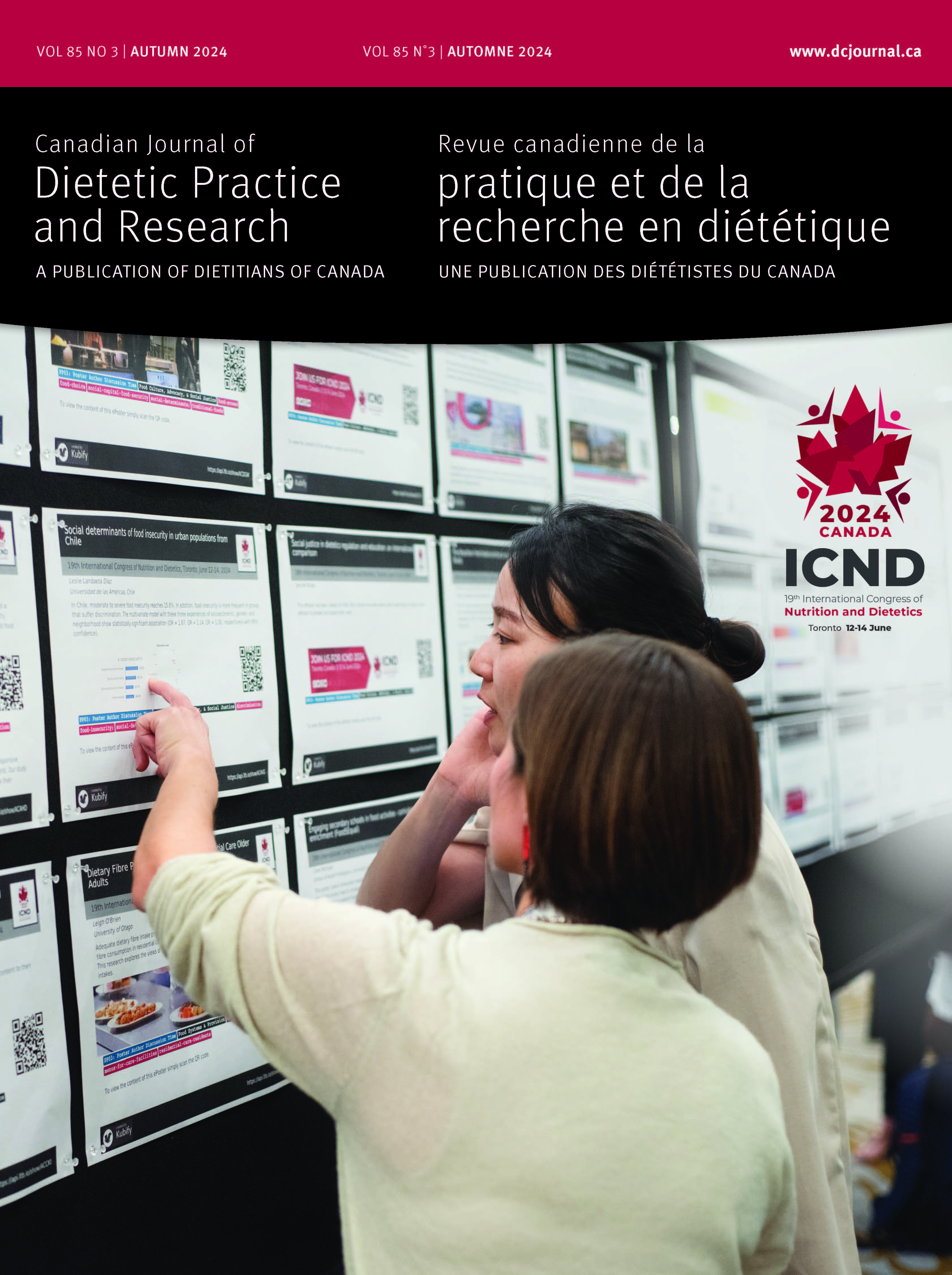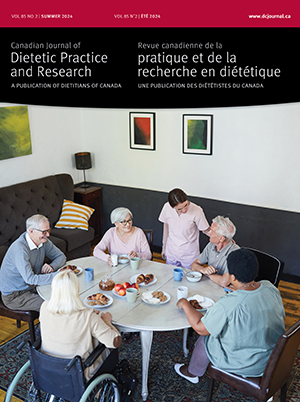Volume 71 • Number 2 • July 2010
Chair’s Message
Editor’s Message
Research
Purpose: An exploration was completed of health professionals’ experiences implementing evidence-based guidelines that promote intensive management (IM) for people with diabetes. Methods: In-depth, semi-structured interviews were conducted with 50 health professionals from across Canada. These professionals are considered to be opinion leaders in diabetes care. Interviews were audiotaped, transcribed verbatim, and coded with the assistance of NVivo software. Transcripts were analyzed using Potter and Wetherell's approach to discourse analysis. Results: Participants noted that recent clinical trials validated intensive approaches to diabetes management. While they viewed the evidence as sound, they did not feel that it justified IM approaches in all situations. Evidence-based practice therefore gave way to individual patient considerations. Implementing behavioural strategies, such as the stages of change model, allowed participants to modify their practices in ways that accommodated both evidence-based and patient-focused practice paradigms. Conclusions: While evidence-based medicine influenced practice, it was only one discourse that shaped the way health professionals approached diabetes care.
Purpose: Photovoice, an innovative qualitative research method in health care, has not been used to its full potential in nutrition/dietetics. We explored the use of Photovoice to determine perceived facilitators of and barriers to healthful eating among university students. Methods: The study included 28 students enrolled in a 2008 introductory nutrition class. The students participated in a camera orientation session to review ethics and privacy issues. They took photographs and selected two for discussion in a focus group moderated by a graduate student who used a semi-structured facilitation guide. Researchers coded the transcripts, analyzed the pictures and students’ written comments about the project, and ensured data trustworthiness through credibility, dependability, confirmability, and transferability of data and methods. Results: Six major themes emerged as facilitators and/or barriers: environment, nutrition knowledge, convenience foods, time, media influence, and food cost. More than onethird of the students thought the study “stimulated their critical thinking.” They felt more empowered in sharing their perceptions and “getting their voices heard.” Conclusions: Photovoice was a useful, “motivating,” and “engaging” method for research on nutrition knowledge and dietary patterns of university students. Registered dietitians and other health professionals may benefit from the use of the Photovoice method when they are working with students.
Purpose: We investigated barriers to healthful eating and vitamin/mineral supplement use among groups at risk for low nutrient intakes, particularly those with low income. Methods: Twelve focus groups (73 participants) and 11 key informant interviews were conducted in Saskatoon, Saskatchewan. Focus group participants represented a diverse population. Key informants included health professionals and personnel from community-based organizations who worked in a lowincome area. Focus group meetings and key informant interviews were audiotaped and transcribed; thematic coding was used to identify key concepts. Results: The focus groups and interviews revealed five themes on barriers to healthful eating and to the use of vitamin/mineral supplements: knowledge, income, accessibility, health, and preferences. Key informants were aware of the barriers, and were able to see not only individual and family reasons but also societal influences. Conclusions: The study results provide valuable information for focusing efforts on reducing barriers to healthful eating and to appropriate vitamin/mineral supplement use.
Purpose: We explored infant nutrition in Saskatoon by assessing current accessibility to all forms of infant nourishment, investigating challenges in terms of access to infant nutrition, and determining the use and effectiveness of infant nutrition programs and services. We also examined recommendations to improve infant food security in Saskatoon. Methods: Semi-structured community focus groups and stakeholder interviews were conducted between June 2006 and August 2006. Thematic analysis was used to identify themes related to infant feeding practices and barriers, as well as recommendations to improve infant food security in Saskatoon. Results:Our study showed that infant food security is a concern among lower-income families in Saskatoon. Barriers that limited breastfeeding sustainability or nourishing infants through other means included knowledge of feeding practices, lack of breastfeeding support, access and affordability of infant formula, transportation, and poverty. Conclusions: Infant nutrition and food security should be improved by expanding education and programming opportunities, increasing breastfeeding support, and identifying acceptable ways to provide emergency formula. If infant food security is to be addressed successfully, discussion and change must occur in social policy and family food security contexts.
Purpose: In order to understand policy-making capacities, we conducted an in-depth examination of three stages of the policy cycle (agenda-setting, formulation, and decision-making) leading to mandatory nutrition labelling, nutrient content claims, and health claims regulations in Canada. Methods: Data were collected through document review and key informant interviews (n=24) conducted with government, industry, health organizations, professional associations, academia, and consumer advocacy groups. Results: The policy-making processes were complex, unpredictable, and often chaotic. In the early stages, progress was hampered by a shortage of resources and negatively affected by policy silos. In spite of formidable barriers, a high degree of stakeholder convergence was achieved, which facilitated ground-breaking policy formulation. Success factors included a common health promotion issue frame that participants adopted early in the consultative process, “champions” within the federal government's health sector, strong advocates within a broad stakeholder community, and an innovative policy-formulation process overseen by an intersectoral advisory committee. Conclusions: Authentic partnerships among government, industry, and key stakeholders strengthened policy-making processes while helping to overcome policy silos at the organizational level. Barriers were reduced through effective change management practices and collaborative advisory and communication processes. Future research should involve an examination of the population health outcomes associated with this policy initiative.
Review
Photovoice is an innovative qualitative method of participatory action research based on health promotion principles; however, it has not been used to its full potential in health care, particularly in nutrition and dietetics. Photovoice is also based upon the theoretical literature on education for critical consciousness, feminist theory, and community-based approaches to documentary photography. Participants take photographs representing their views on a specific topic and discuss them in a group process of critical reflection. Originally designed for research with rural women, Photovoice has been used with a variety of population groups throughout the lifespan, such as adolescents, nurses and nursing students, professional groups, Aboriginal women, the elderly, immigrant and low-income groups, and patients with a variety of diseases. The use of Photovoice as a research method is not restricted by health conditions, financial situation, employment status, or literacy level. It is used in community settings, professional practice, or institutional learning environments to explore participants’ views and opinions. We review studies in which Photovoice has been used, as well as the impacts, advantages, limitations, and ethics of its use. Gaps in knowledge and its potential use in nutrition and dietetic research are identified.
Perspectives in Practice
Producing a definition of healthful eating that expresses adequately the richness and the complexity of the eating experience is challenging. Still, the effort is crucial if one wants to promote behavioural change in the population, as well as a transformation of interventional practices, programs, and policies, and even the agri-food system. We explain that the biological, social, and environmental dimensions of healthful eating, along with the interactions among them, must be addressed. Once these dimensions are considered as a whole, the definition of healthful eating allows the identification of a wide range of strategic interventions to implement such eating. We suggest a continuum of eating quality that could be used to identify, in general, the food habits of persons or groups.
Report
Purpose: The likelihood of experiencing poor nutrition status increases as people age. Sampling new foods may promote a continued interest in food and enjoyment of eating. This pilot study was designed to describe and provide a preliminary evaluation of food-tasting activities integrated into nutrition displays directed at community-living older adults. Methods: Three consecutivemonthly nutrition displays incorporating a food-tasting activity were presented at a Guelph, Ontario, recreation centre for seniors. Seniors had an opportunity to taste two recipes at each of three displays; 226 food samples and 155 copies of recipes were taken. Feedback forms were used to determine participants’ interest inmaking the recipes, and whether tasting influenced their interest in preparing the food. Results: Among 54 participants who completed feedback forms about the program, 75.9%indicated that they intended to prepare one or both of the recipes tasted at the display; 70.4%indicated that they would not ormay not havemade the recipe without tasting it beforehand. Conclusions:Dietitians working with community-living older adults could use food tastings to help translate key educational messages into practice, and to encourage eating enjoyment as people age.










